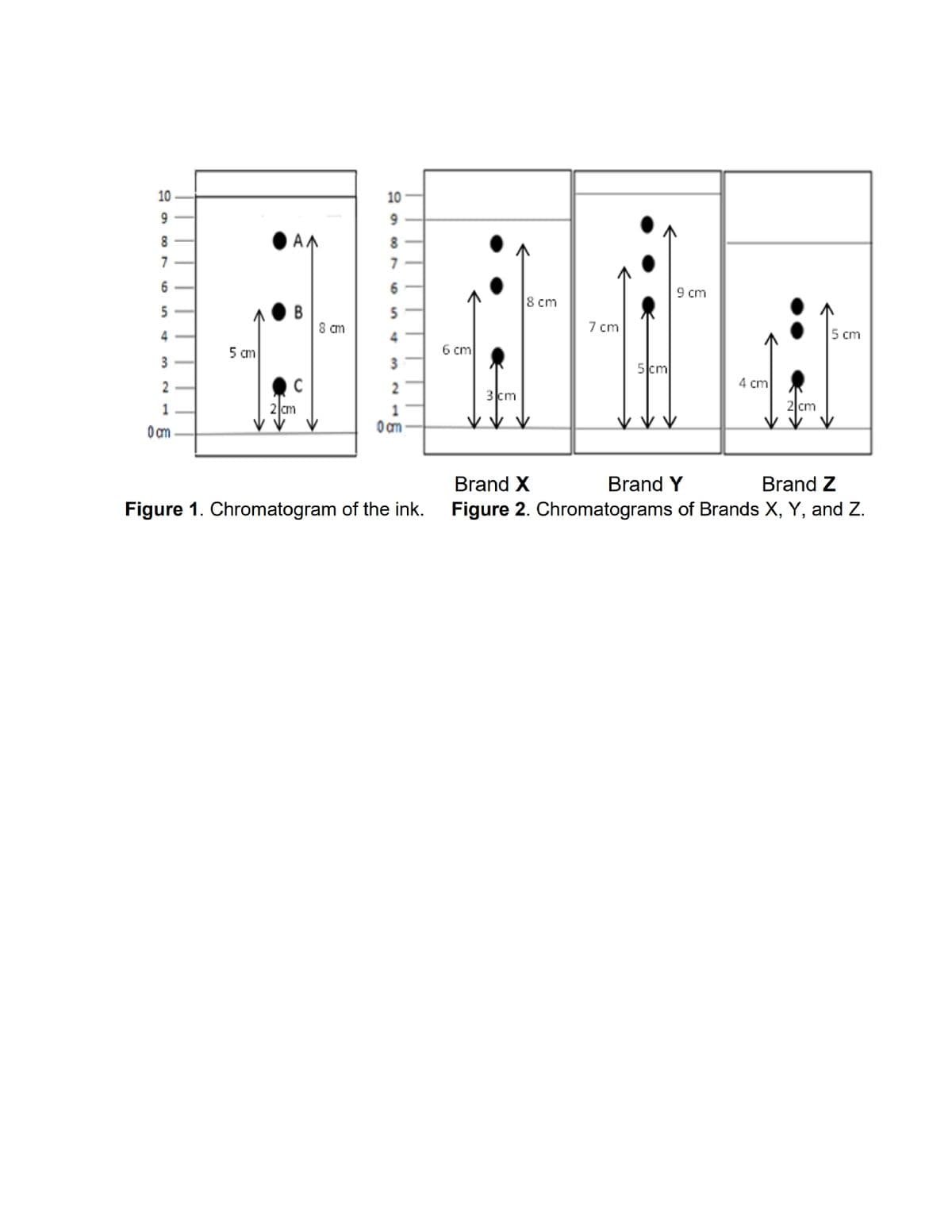Using paper chromatography, a Chem 16 student tried to separate the components of an ink using 0.01% NaCl solution as mobile phase. His chromatogram is shown in figure 1. *rely on the picture* The student tried to identify whether component B can also be found in other pen brands so with the same mobile phase, he ran a paper chromatography experiment using brands X, Y, and Z. The results are shown in figure 2. A. Calculate the retention factors of components A, B, and C in figure 1. B. Arrange components A, B, and C in order of increasing polarity. C. From the results of his experiment, component B can also be found in which brand/s?
Using paper chromatography, a Chem 16 student tried to separate the components of an ink using 0.01% NaCl solution as mobile phase. His chromatogram is shown in figure 1. *rely on the picture* The student tried to identify whether component B can also be found in other pen brands so with the same mobile phase, he ran a paper chromatography experiment using brands X, Y, and Z. The results are shown in figure 2. A. Calculate the retention factors of components A, B, and C in figure 1. B. Arrange components A, B, and C in order of increasing polarity. C. From the results of his experiment, component B can also be found in which brand/s?
Chemical Principles in the Laboratory
11th Edition
ISBN:9781305264434
Author:Emil Slowinski, Wayne C. Wolsey, Robert Rossi
Publisher:Emil Slowinski, Wayne C. Wolsey, Robert Rossi
Chapter2: Resolution Of Matter Into Pure Substances, I.paper Chromatography
Section: Chapter Questions
Problem 2ASA
Related questions
Question
SHOW CLEAR SOLUTION:
Using paper chromatography, a Chem 16 student tried to separate the components
of an ink using 0.01% NaCl solution as mobile phase. His chromatogram is shown
in figure 1.
*rely on the picture*
The student tried to identify whether component B can also be found in other pen
brands so with the same mobile phase, he ran a paper chromatography experiment
using brands X, Y, and Z. The results are shown in figure 2.
A. Calculate the retention factors of components A, B, and C in figure 1.
B. Arrange components A, B, and C in order of increasing polarity.
C. From the results of his experiment, component B can also be found in which
brand/s?

Transcribed Image Text:10
68
9
8
7
6
5
4
3
2
1
0 cm
5 cm
ΑΛ
B
2 cm
8 cm
10
9
8
7
6
5
4
3
2
1
0 cm
Figure 1. Chromatogram of the ink.
6 cm
3 cm
8 cm
7 cm
5 cm
9 cm
4 cm
5 cm
Brand X
Brand Y
Brand Z
Figure 2. Chromatograms of Brands X, Y, and Z.
Expert Solution
This question has been solved!
Explore an expertly crafted, step-by-step solution for a thorough understanding of key concepts.
Step by step
Solved in 4 steps with 4 images

Knowledge Booster
Learn more about
Need a deep-dive on the concept behind this application? Look no further. Learn more about this topic, chemistry and related others by exploring similar questions and additional content below.Recommended textbooks for you

Chemical Principles in the Laboratory
Chemistry
ISBN:
9781305264434
Author:
Emil Slowinski, Wayne C. Wolsey, Robert Rossi
Publisher:
Brooks Cole

Principles of Instrumental Analysis
Chemistry
ISBN:
9781305577213
Author:
Douglas A. Skoog, F. James Holler, Stanley R. Crouch
Publisher:
Cengage Learning


Chemical Principles in the Laboratory
Chemistry
ISBN:
9781305264434
Author:
Emil Slowinski, Wayne C. Wolsey, Robert Rossi
Publisher:
Brooks Cole

Principles of Instrumental Analysis
Chemistry
ISBN:
9781305577213
Author:
Douglas A. Skoog, F. James Holler, Stanley R. Crouch
Publisher:
Cengage Learning



Chemistry: Matter and Change
Chemistry
ISBN:
9780078746376
Author:
Dinah Zike, Laurel Dingrando, Nicholas Hainen, Cheryl Wistrom
Publisher:
Glencoe/McGraw-Hill School Pub Co